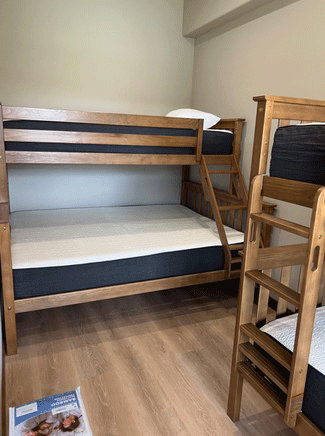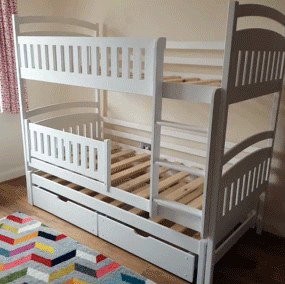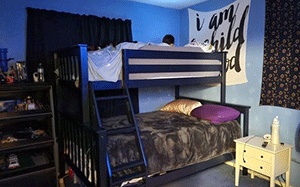If you’re looking to maximize space without sacrificing style or durability, the Plank and Beam Bunk Bed might just be the perfect solution. As someone who recently purchased this bunk bed for my guest room, I can confidently say it’s been a game-changer. In this review, I’ll share my experience, break down the pros and cons, and give you tips on how to get the most out of it. Whether you’re furnishing a small apartment, a cabin, or a kid’s room, this article will help you decide if this bunk bed is right for you. Let’s dive in!
My Experience With The Plank And Beam Bunk Bed
When I first decided to buy a bunk bed, I was overwhelmed by the options. But after researching, I landed on the Plank and Beam Bunk Bed because of its solid wood construction and sleek design. Here’s how my experience went:

- Unboxing: The bed arrived in one heavy box, which was a bit of a challenge to move, but the packaging was secure and all parts were intact.
- Assembly: The instructions were clear, and I was able to assemble it myself with a little help lifting the top bunk into place. It took about 2 hours, but the process was straightforward.
- First Impressions: The natural finish looked stunning, and the solid wood felt incredibly sturdy. It instantly elevated the look of my guest room.
- First Use: My guests loved it! The bed comfortably fit standard mattresses, and the 400 lb weight capacity per bunk gave me peace of mind.
- Long-Term Use: After several months, the bed still looks and feels brand new. It’s held up beautifully, even with frequent use.
Pros Of The Plank And Beam Bunk Bed
Here’s why I think the Plank and Beam Bunk Bed stands out:
Read More: My Thought on Bob’s Vs. Ashley Furniture
- Solid Wood Construction: Made from knot-free New Zealand pine, this bed is built to last. It feels premium and durable.
- Space-Saving Design: The stacked design is perfect for small spaces, and it can be separated into two freestanding beds if needed.
- High Weight Capacity: With a 400 lb weight limit per bunk, it’s suitable for both kids and adults.
- Low VOC Finish: The hand-applied, low VOC finish is safe for my family and contributes to a healthy home environment.
- Easy Assembly: The instructions were clear, and all necessary tools and hardware were included.
- Versatile Mattress Compatibility: It works with all mattress types, including memory foam, spring, hybrid, or latex.
- Stylish Design: The natural finish and clean lines make it a stylish addition to any room.
- Durable Slats: The solid wood plywood slats and metal support bar ensure long-lasting support.
- Safety Compliant: It meets or exceeds US and EU safety standards, so I feel confident using it.
- Great for Guests: It’s perfect for guest rooms, cabins, or vacation homes where space is limited.
Cons Of The Plank And Beam Bunk Bed
No product is perfect, and the Plank and Beam Bunk Bed has a few drawbacks:
- Heavy: The solid wood construction makes it heavy, which can be challenging to move or assemble without help.
- Pricey: It’s more expensive than some other bunk beds, but the quality justifies the cost.
- Limited Color Options: The natural finish is beautiful, but it might not suit everyone’s decor preferences.
- Assembly Time: While straightforward, assembly can take a couple of hours, especially if you’re doing it alone.
- Mattress Height Limitation: An 8-inch mattress is recommended for the best fit, which might not work for thicker mattresses.
- Bulky Packaging: The single-box packaging is secure but can be difficult to maneuver in tight spaces.
- Not Ideal for Very Young Kids: While safe, the height might be intimidating for very young children.
- No Storage: Unlike some bunk beds, this one doesn’t come with built-in storage options.
How To Get The Most Out Of Your Plank And Beam Bunk Bed
To maximize the benefits of this bunk bed, here are some tips I’ve learned:

- Follow the Instructions: Take your time during assembly and follow the instructions carefully to ensure stability.
- Use the Right Mattress: Stick to the recommended 8-inch mattress for the best fit and comfort.
- Secure the Bed: If using it for kids, consider anchoring it to the wall for added safety.
- Regular Maintenance: Tighten screws and bolts periodically to keep the bed sturdy.
- Add Bed Rails: For younger children, add bed rails to the top bunk for extra safety.
- Decorate Thoughtfully: Use bedding and accessories that complement the natural wood finish for a cohesive look.
- Rotate Use: If separating into two beds, rotate their use to ensure even wear and tear.
- Clean Gently: Use a soft cloth and mild cleaner to maintain the finish and keep it looking new.
- Maximize Space: Use under-bed storage bins to make the most of the space beneath the bottom bunk.
- Check Weight Limits: Always adhere to the 400 lb weight limit per bunk to ensure safety and durability.
Plank And Beam Bunk Bed Vs. Other Brands
Let’s see how the Plank and Beam Bunk Bed stacks up against some popular competitors:
Read More: My Thought on Bob’s Vs. Ashley Furniture
Plank and Beam vs. Metal Bunk Beds
- Durability: Solid wood is more durable and aesthetically pleasing compared to metal, which can feel cold and industrial.
- Weight Capacity: The Plank and Beam Bunk Bed offers a higher weight capacity (400 lbs per bunk) than most metal bunk beds.
- Safety: Metal beds can squeak or wobble over time, while the solid wood construction of Plank and Beam ensures stability.
Plank and Beam vs. Particleboard Bunk Beds
- Quality: Particleboard is less durable and can chip or warp, while solid wood is long-lasting and sturdy.
- Eco-Friendliness: The low VOC finish and solid wood make Plank and Beam a healthier and more sustainable choice.
- Aesthetics: Solid wood has a timeless, high-end look compared to the cheaper appearance of particleboard.
Plank and Beam vs. Built-In Storage Bunk Beds
- Space Efficiency: While built-in storage is convenient, the Plank and Beam Bunk Bed’s sleek design saves more floor space.
- Versatility: The ability to separate into two beds gives Plank and Beam an edge in terms of flexibility.
- Design: The minimalist design of Plank and Beam fits seamlessly into any decor, whereas storage bunk beds can look bulky.
Maintenance: Keeping Your Bunk Bed In Top Shape
To ensure your Plank and Beam Bunk Bed stays sturdy, safe, and beautiful for years to come, here are some maintenance tips I’ve learned:

- Tighten Bolts Regularly: Over time, screws and bolts can loosen. Check and tighten them every few months to maintain stability.
- Clean Gently: Use a soft cloth and mild cleaner to wipe down the wood. Avoid harsh chemicals that could damage the finish.
- Inspect for Wear: Regularly check for cracks, splinters, or other signs of wear, especially if kids are using the bed.
- Rotate Mattresses: If you separate the bunks into two beds, rotate the mattresses periodically to ensure even wear.
- Avoid Excess Weight: Stick to the 400 lb weight limit per bunk to prevent strain on the frame.
- Use Protective Pads: Add felt pads under the legs to protect your floors and prevent scratches.
- Keep it Dry: Avoid placing the bed in damp areas, as moisture can damage the wood over time.
- Anchor for Safety: If using the top bunk for kids, consider anchoring the bed to the wall for added security.
- Refresh the Finish: If the wood starts to look dull, use a wood polish or conditioner to restore its shine.
- Store Properly: If disassembling, store all parts in a dry, safe place to prevent damage or loss.
Frequently Asked Questions (Faq)
Let’s address some common questions about the Plank and Beam Bunk Bed based on my experience and research.
The top bunk is often preferred by kids for the fun factor, but the bottom bunk is more practical for adults or those who prefer easier access. With the Plank and Beam Bunk Bed, both bunks are equally sturdy and comfortable, so it’s really a matter of personal preference.
While bunk beds are generally safe, there are a few potential downsides:
Risk of falls, especially for young children.
Limited headroom on the bottom bunk.
Climbing up and down can be challenging for some.
However, with proper safety measures (like guardrails and sturdy construction), these risks can be minimized.
Solid wood, like the New Zealand pine used in the Plank and Beam Bunk Bed, is the best material for bunk beds. It’s durable, sturdy, and aesthetically pleasing. Metal bunk beds can be noisy and less stable, while particleboard is less durable and can warp over time.
Conclusion
If you’re looking for a bunk bed that combines style, durability, and functionality, the Plank and Beam Bunk Bed is a product you need to consider. My experience has been overwhelmingly positive, and I believe it can do the same for you. Remember, proper maintenance and safety measures are key to getting the most out of it. Don’t wait—take the first step toward a more organized and stylish space today!
